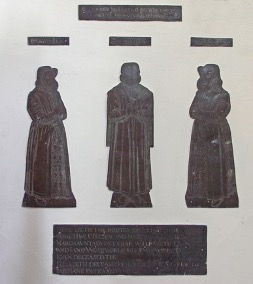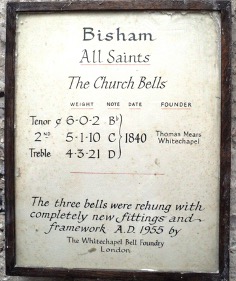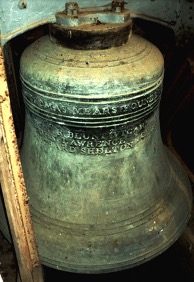Newsletter No. 8 April 2020
- Apr 28, 2020
- 11 min read
Updated: Apr 20, 2021

The Brinkhurst Brasses
Bisham Priory
Bisham's Bells
Events
Patricia Burstall's Memorial Plaque
I took the banner photo of the church and the one of Bisham Abbey from across the river during the flooding in late January, unaware of the crisis which would engulf the world within weeks. Now, locked down at home, my thoughts are with all our Friends in Bisham, Marlow and as far away as Australia and the USA, facing the stress of the Covid-19 global pandemic. We are all in this together, when a shared sense of community takes on heightened meaning. The aim of our scheme, to centre a community of Friends on a beautiful historic building in a peaceful Thames-side setting, is all the more pertinent at this time.
It is a happy coincidence that our register of members has reached 100 in the same month as the issue of this newsletter because, with Steve and Jackie Rowlands’ permission, I am able to share the message which accompanied their application:

“We’re both very happy to support The Friends. We were married in the church in 2016 so the church has a special meaning for us both as a beautiful building in an idyllic location and as a place of worship, serenity and calm. We have made many new friends through All Saints’ Bisham and hope that membership of The Friends will help to support the enduring future of this lovely, historic building and all that it symbolises.”
I could not express better what Bisham Church Friends is all about and hope that the church will continue to have a special meaning for all our Friends, in their own personal ways.
Friends are our best ambassadors, so do please spread the word about the scheme, wherever you may be. Joining, via our website www.bishamchurchfriends.org or through an email to welcome@bishamchurchfriends.org, is a simple matter and, while donations of whatever size are most helpful, they are not a prerequisite of membership. (Above photo courtesy of Steve and Jackie Rowlands)
Sheila Featherstone-Clark told us in the last newsletter as much as is known about the Thomas Crekett brass. The other brasses, of the merchant venturer John Brinkhurst and his two wives, have a fascinating history behind them, which Sheila explains in this newsletter.
Although only peripheral to the history of the church, the former priory has connections with the Abbey, which has even stronger connections with the church. There is even a link with the east window, which John Harper described so well in our last newsletter. So when John offered an article on the priory, I felt sure you would find it interesting.
Michael Eagleton, well known in the local media and a Friend of Bisham Church, wrote about the bells of Bisham in the Marlow Free Press in February. In case you missed this, you can read about the bells and see some of Michael’s excellent photos here.
It has always been our aim to arrange at least two events each year for Friends, usually open to all. The Tingalpa lunch in October was an enjoyable occasion. Sadly, we have had to cancel the Summer Garden Party scheduled for 11 July and put our other plans on hold because of the present restrictions. We look forward to arranging events again as soon as it is safe to do so. You will find mention of these here and on the website, which will be kept updated.
Our Church Warden describes the placing of a memorial plaque for Patricia Burstall in the church. We have a photo here of the ceremony in January.
If you would like to offer an article for the newsletter, do please contact me. The next issue is scheduled for September. This may be one more way in which you can give your support, as Friends, to the preservation of the building and the strengthening of the community, for which we are most grateful.
Finally, I can’t resist sharing an unexpected fact, passed to me by a Friend: there was a Royal Navy vessel named HMS Bisham, a Ham-class inshore minesweeper, launched on 6 March 1954 and destroyed by fire on 29 September 1956.
Robert Frost
Chairman
The Brinkhurst Brasses (Sheila Featherstone-Clark)

The Brinkhurst family owned Temple Mills in the 1500s. Temple was included in the Bisham estate when it was given to Anne of Cleves as part of her divorce settlement from Henry VIII. She exchanged part of the estate for one in Suffolk owned by the Hoby family who came to Bisham and granted Temple Mills to her cofferer, Thomas Persse. He in turn conveyed Temple Island and the Buckinghamshire side of the river, with the wool mills, to John Brinkurst, a wool merchant, in 1544.
The wool trade had enabled a growing number of its most influential merchants to form an affluent and important merchant middle class. In the 15th Century the English Company of Merchant Venturers had become the most important group of traders in Europe, having taken control of the market from the Hanse which had previously controlled the trade.
The second John Brinkhurst, nephew of the first, was the most affluent and powerful of this local family; he was a Merchant Venturer. He married twice but had no children. It is he and his wives who are depicted in the impressive Bisham brasses, which tell us a great deal about him in a few words. The inscription reads: “Here lieth the Bodye of John Brinkhurst, sometime citizen and Mercer of London and Merchant Venturer”.
Merchant Venturers, of which the company of Mercers was the most powerful, were importers and exporters dealing in fine cloths, silks, velvets and luxury goods. They had ships, they took risks and could wait for a return on their capital. This required vast wealth. Their main export was wool, although they made more profit from luxury cloth. By 1497 the London Company of Merchant Venturers had in fact become a national company and by the middle of the 16th Century their cloth exports alone amounted to over £1m per annum (£270m today). After the accession of James I, they re-established themselves in Hamburg. They were then the trading masters of Europe.
The brassesdepict John Brinkhurst, in civilian dress, wearing a doublet, buttoned close, with a long gown reaching to the feet, and with false sleeves hanging down from behind his shoulders.They alsodepict John Brinkhurst’s two wives. The first was Elizabeth Blundell whom he married at Bisham in May 1567; she died in 1581. He then married Jane Woodford (Wodfoorde),of Brightwell, who outlived him by two years, dying in 1616. The two female effigies in the brass wear the paris headdress or close cap, with a lappet or veil hanging behind. The fronts of their dresses are open, showing the petticoat ornamented with very elaborate patterns.
The plate containing two Latin verses probably refers to the transitory nature of the life of man “who flourisheth as a flower of the field”. There are two Latin verses and mottoes over each effigy.
The brasses are the product of the Gerard Johnson workshop in London, and the plates have been removed from their original slab formerly on the floor of the Chancel, probably during the extensive restoration undertaken in 1849. They were repositioned in 1921.
John Brinkhurst, who had great wealth, became a public benefactor. In his lifetime he founded and endowed the alms houses in Oxford Lane, Marlow for “6 poor widows of good character”, 2 of which to be from Bisham. Despite his two marriages, he died childless. His estates passed via his brother Richard to his nephew John (“Yet another Joyn”), but despite the fact that they kept the estate for nearly a hundred years, dark clouds were hanging over the Brinkhurst family. The blanks left in the Bisham brass show the first hint of trouble; spaces had been left to add the date of John’s death and that of his second wife Jane, but both were left empty. Perhaps this was because the Brinkhursts, as a stalwart Catholic family, had become personae non gratae. By the early 18th Century all their wealth and lands must have gone as they were fined regularly as Catholic recusants.
Bisham Priory (John Harper)
Bisham has always been proud of its abbey but it is probably not generally known that as a true ecclesiastical abbey, it actually existed for less than a year. The imposing property, nowadays identified by that name, is the house built by the Hoby family on the same site on acquisition of the manor almost twenty years after the monks had been expelled.
Many centuries before, the manor of Bisham had been ceded to the Knights Templars by Robert, Earl Ferrers, to whose family it had been awarded by William I following the Conquest. In 1308 the Templars were suppressed and, on its reversion to Edward II, the manor was passed on by him in quick succession to various relatives or political insiders. By 1336, the manor had become the property of the first Earl of Salisbury, of the Montacute family, which had been steady supporters of both the Norman and Plantagenet monarchies. William Montacute petitioned for the establishment of a priory, which was granted in 1337.
Very little is now known about the structure itself, but some records still exist detailing its financial affairs and its administration. It now seems clear that the priory, a house of Austin canons, had been under-endowed (Salisbury, at his death, still being owed very substantial amounts by Edward III) and from the surviving papers it would seem that its financial difficulties had been further aggravated by the impact of disease (including the Black Death) and by the extent to which the priory was expected to offer hospitality, particularly in view of its proximity to Windsor. The diversion of some tithe-appropriations from churches as far away as Wales, Somerset and the Isle of Wight probably offered some relief, but economic problems continued during most of its existence.
The priory, however, was still functioning actively by the time that the storm clouds of Dissolution were gathering in the mid-1530s. In 1536 Henry VIII’s notorious enforcer, Thomas Cromwell, sought and succeeded in installing his placeman, William Barlow, as Prior (who remained conspicuously absent from the priory throughout his short tenure) against opposition from the Salisbury family and the priory itself. The inevitable surrender of the foundation followed in the next year in line with Henry’s national strategy, but the king then perversely decided, on a passing notion, to retain the priory as a form of chantry for himself, with prayers also to be said for the soul of his late queen, Jane Seymour. It was to be re-established with the full status of a Benedictine abbey. Cromwell had other plans, having previously negotiated rights elsewhere on its planned dissolution. Reluctant to see a financial opportunity slip through his fingers, and with the king rapidly cooling to his earlier idea, this resurrection was short-lived. The abbey was closed down within six months, and its few remaining possessions were quickly sold off, the building being largely demolished.
The priory had, however, acquired a particular claim to distinction. From 1337 the Montacute (or Montagu) family, and their connections by marriage - the powerful Nevilles - held continuous occupation of the manor of Bisham until the removal to the Tower of London of Margaret, Countess of Salisbury, in 1539. She was to be executed in grotesque circumstances two years later on the entirely spurious grounds of treason in her 68th year, in pursuit of the king’s vendetta against the exiled Reginald Pole (her son) and his family. As she was the surviving child of the Duke of Clarence, she also always represented a potential threat to the throne to which Henry’s father’s claim had been, of course, extremely shaky.
The priory had been the natural burial site of a number of significant nobles, including Richard, Earl of Warwick (‘Warwick the Kingmaker’), and the first four Earls of Salisbury, all of whom distinguished themselves in the wars against France. Among them was Thomas, the fourth earl, who fought at Harfleur and Agincourt with Henry V (he is depicted in the east window of Bisham Church) and Prince Edward, son of the unfortunate Duke of Clarence (brother of both Edward IV and Richard III), whom legend claims to have been killed by being drowned in a butt of malmsey. No trace of any tomb now survives, but their ultimate places of rest are believed to be under the foundations of the Hobys’ house, which has since been known as the Abbey, or within its immediate precincts.
Perhaps, like Richard III, their remains will be discovered one day - it would certainly be far better to let them remain in peace.

Bisham Abbey
Bisham’s Bells (Michael Eagleton)
Although I never became a bell ringer, church bells have held a fascination for me since my early school days and I have had the privilege of being allowed to visit most of the church towers in this local area over the past couple of decades. I remember that getting up to the single bell in St. Peter’s Roman Catholic Church in 2014 was the most hazardous!
Around 10.30am on Thursday 23rd January the villagers of Bisham might have heard a rare occurrence, the three bells of All Saints’ Church sounding together. These days only one, and occasionally three at weddings, are just chimed and not rung. I suspect this is due to lack of volunteers to pull the ropes, but it might also be concern for the well-being of the 12th Century Norman tower and the possible effects of the combined weight of fifteen hundredweight of swinging bells.

I was to blame for the triple sounding, but I just tapped the bells without swinging them or pulling on the ropes. I had been allowed to visit the church tower courtesy of my neighbour and Chairman of the Bisham Church Friends, Robert Frost, and also the church warden Rod Stevens. The climb is another tricky one: up a very narrow and very steep wooden staircase into the ringing room, and then, by means of a long ladder, up through a trapdoor, passing some very awkward beams, to reach the bells themselves. I had made the same ascent some years ago (slightly more agile then!) but only black and white photos resulted, and I wanted some colour ones. Nothing had changed in the draughty bell room. In fact, in view of the cobwebs, I wondered how many others had visited since my last trip.
Events
Tingalpa Lunch
On 6 October 2019 a lunch was held in the church to meet the President of the Tingalpa Friends Group, Geoff Doherty, and his wife Marg, following an article in the September newsletter covering the historic link between Bisham Church and Tingalpa Cemetery & Chapel, Queensland, Australia.

Photo Sheila Featherstone-Clark
Sadly, we have had to cease holding Friends’ events for the foreseeable future due to the Covid-19 situation.
Friends Summer Garden Party
This event was to have taken place on 11 July 2020. We would still like to hold a garden party at the church as a “thank you” for Friends and shall aim to do so when the crisis is over and the weather is right.
History Talk No 2
Sheila Featherstone-Clark, who gave a talk in May 2019 on Bisham’s people and personalities in the Elizabethan period, is preparing a second talk focusing on the 20th Century.
Visit to St John’s College, Oxford
Revd Elizabeth Macfarlane, formerly Marlow Team Vicar and now Chaplain of St John’s, has offered to show Bisham Church Friends round the College “once normality returns”. We look forward to arranging a visit in due course.
Guided tours of the church
We plan to arrange guided tours, particularly for those who have never been inside the church or only infrequently, as soon as conditions allow. Details will be given on the website and elsewhere.
Patricia Burstall’s memorial plaque(Rod Stevens, Church Warden)

On 14 January the memorial plaque in memory of the late Patricia Burstall was put into position on the north wall of the north aisle of All Saints’ Bisham.That afternoon Revd Dave Bull dedicated the plaque in the presence of about 20 of Patricia’s close friends, including Sandi Gifford who with her family had generously provided the finance.
Service times
In line with churches throughout the country, the church building will remain closed until further notice. The church, however, remains active, thanks to the efforts of many people and the resilience of the internet, both under pressure at this time.
Normally, services at Bisham are held at 8am (Holy Communion) and 9.30am (informal worship) on the 1st Sunday in the month and at 9.30am (Sung Eucharist) on other Sundays. These have been replaced by a traditional service online at 9.30am and a contemporary service at 11am. Details of these, and other activities, can be found at www.4u-team.org/digitalchurch.











Comments